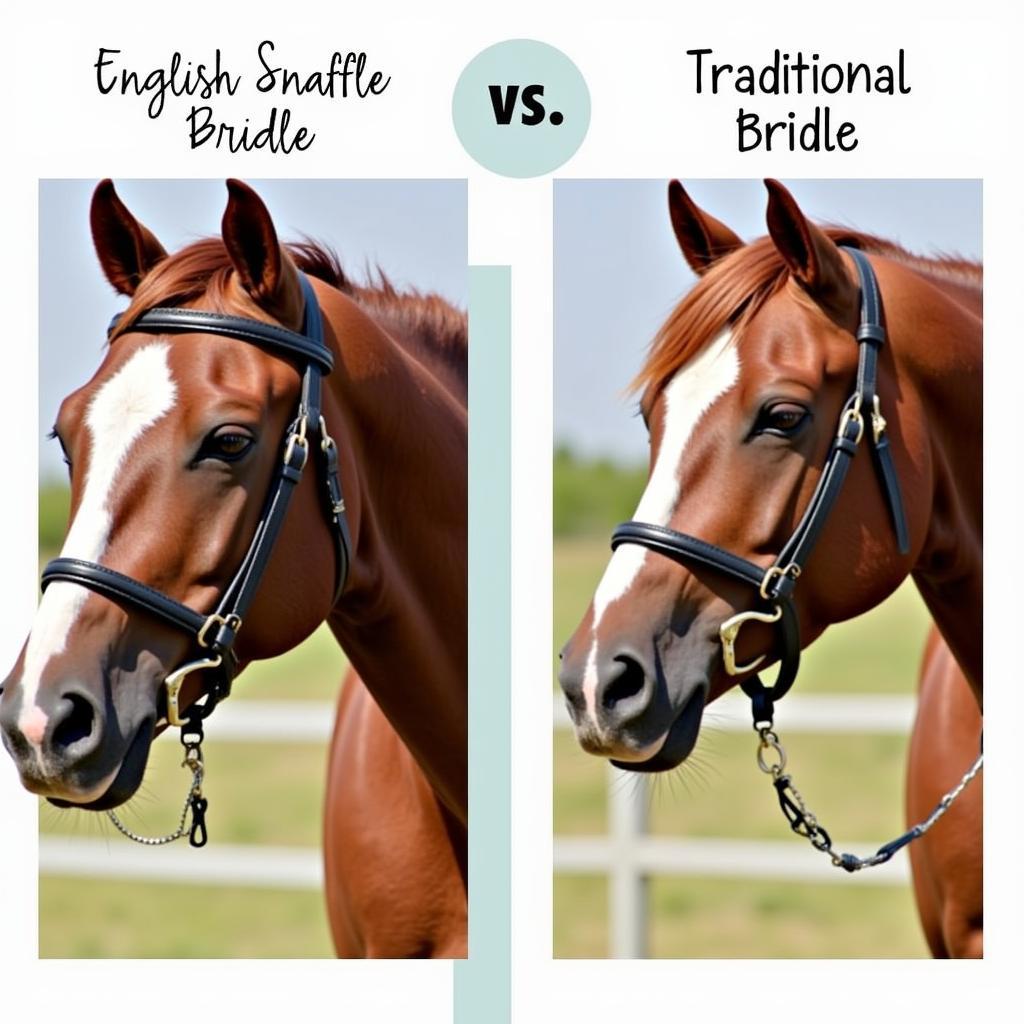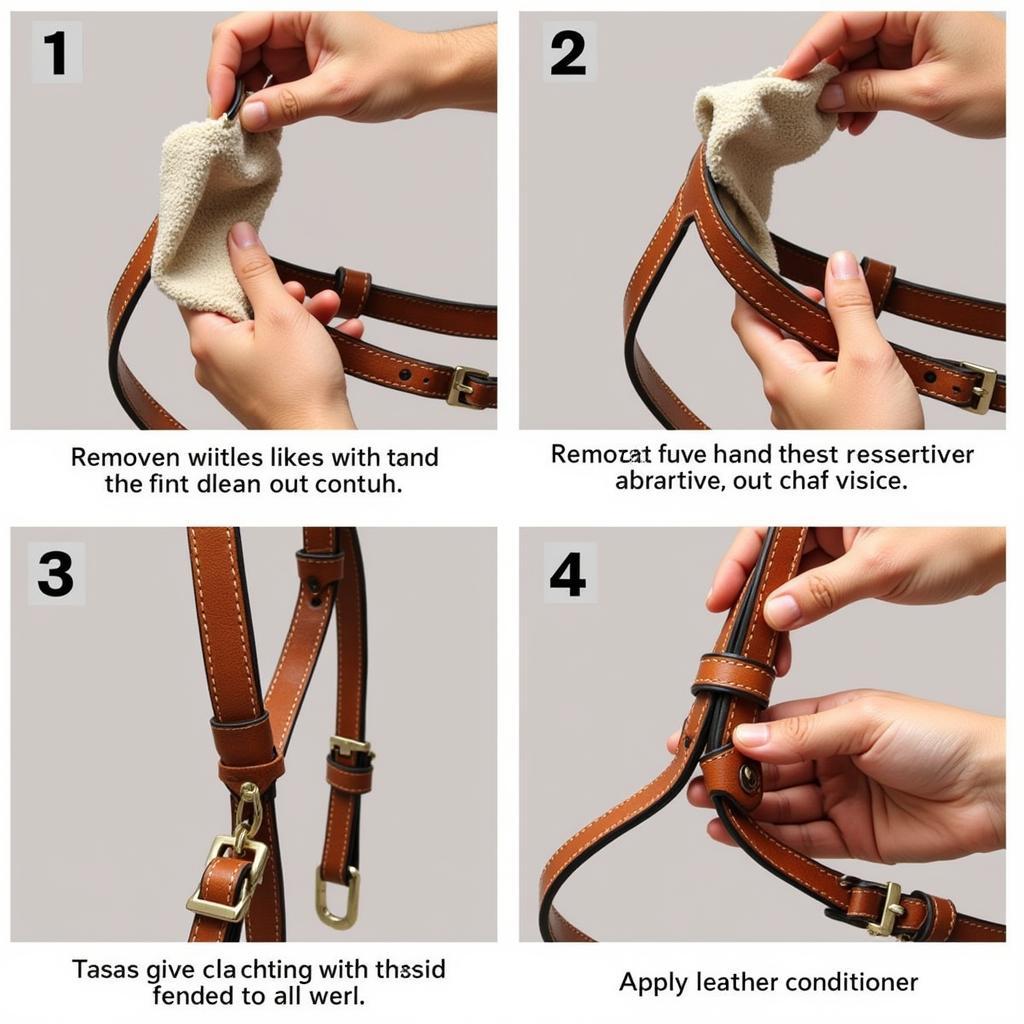Leather bridles are an essential piece of equipment for any horse owner. They provide a way to communicate with and control your horse while riding. But with so many different types of leather bridles on the market, it can be tough to know which one is right for you and your horse. This comprehensive guide will provide you with all the information you need to choose the perfect leather bridle, from the different types of bridles available to the factors you should consider before making your purchase.
Understanding Leather Bridles
A horse bridle is more than just a headstall; it’s a system of straps that work together to provide control and communication between horse and rider. Here’s a breakdown of the key components:
- Crownpiece: This strap sits behind the horse’s ears, distributing pressure evenly across the poll and keeping the bridle securely in place.
- Cheekpieces: These straps run down the sides of the horse’s face, connecting the crownpiece to the bit. They play a vital role in adjusting the bit’s position and influencing rein aids.
- Throatlatch: Fastening under the horse’s throat, this strap prevents the bridle from slipping over the ears. It should be adjusted to allow a comfortable fit without restricting breathing.
- Browband: This decorative strap sits across the horse’s forehead, adding a touch of style while helping to keep the crownpiece in position.
- Noseband: Not all bridles have a noseband, but those that do use it to prevent the horse from opening its mouth too wide or crossing its jaw. There are different types of nosebands, each with its own purpose.
- Bit: This metal mouthpiece sits in the horse’s mouth and is the primary tool for communication. Different bits offer varying levels of control and pressure.
Types of Leather Bridles for Horses
 English vs. Western Bridles
English vs. Western Bridles
There is a wide array of leather bridles designed for different riding disciplines and horse needs. Some of the most common types include:
1. Snaffle Bridles: Known for their simplicity, snaffle bridles feature a single bit and are widely used in English riding disciplines like dressage, show jumping, and general riding.
2. Double Bridles: Used primarily in advanced dressage, double bridles utilize two bits—a bradoon and a curb—providing more refined control and communication.
3. Pelham Bridles: These bridles offer the option of using one or two bits, making them a versatile choice. They feature a single cheekpiece with extra rings for different configurations.
4. Western Bridles: Characterized by their lack of a noseband and often featuring decorative silver conchos, western bridles are used in various western riding disciplines.
5. Bitless Bridles: As the name suggests, these bridles do not use a bit. Instead, they rely on pressure points on the horse’s head to provide control. Bitless options are gaining popularity among riders seeking gentler alternatives.
Choosing the Right Leather Bridle for Your Horse
Selecting the right bridle is crucial for your horse’s comfort and performance. Here are key factors to consider:
1. Riding Discipline: The type of riding you do will largely dictate the most appropriate bridle. English and western disciplines have distinct bridle styles, so choose one that aligns with your riding goals.
2. Horse’s Age and Experience: Young or inexperienced horses generally start with a simple snaffle bridle, while more advanced horses in disciplines like dressage may progress to a double bridle.
3. Horse’s Head Size and Shape: Bridles come in different sizes to accommodate various head shapes. Proper fit is essential for comfort and to prevent rubbing or discomfort.
4. Quality of Leather: Invest in a bridle made from high-quality leather. It will be more durable, supple, and comfortable for your horse.
5. Budget: Leather bridles can range in price, so determine a budget before you start shopping. Remember that a well-made bridle is an investment that can last for years with proper care.
Caring for Your Leather Bridle
 Cleaning a Leather Bridle
Cleaning a Leather Bridle
Proper care is essential for maintaining the quality and longevity of your leather bridle. Follow these steps:
- Clean After Every Use: After each ride, wipe down the bridle with a damp cloth to remove sweat, dirt, and debris.
- Deep Clean Regularly: Use a leather cleaner specifically designed for horse tack to give your bridle a thorough cleaning.
- Condition the Leather: Leather conditioner helps keep the leather supple and prevents it from drying out and cracking.
- Store Properly: Store your bridle in a cool, dry place when not in use. Avoid storing it in direct sunlight or extreme temperatures.
Conclusion
Choosing the right leather bridle for your horse is an important decision. By considering your riding discipline, your horse’s needs, and the quality of the bridle, you can find the perfect option for a safe and enjoyable riding experience. Don’t forget to take good care of your bridle to ensure its longevity and keep it looking its best.
FAQ
1. How often should I replace my horse’s bridle?
With proper care, a good quality leather bridle can last for many years. However, it’s important to inspect it regularly for any signs of wear and tear and replace it if necessary.
2. Can I use a leather conditioner on a synthetic bridle?
No, leather conditioner is specifically designed for use on leather. Using it on a synthetic bridle could damage the material.
3. How do I know if a bridle fits my horse correctly?
A properly fitted bridle should be snug but not too tight. You should be able to fit two fingers comfortably between the bridle and your horse’s skin.
4. What are the benefits of using a leather bridle?
Leather is a natural material that is both durable and comfortable for your horse. It is also breathable, which helps to prevent your horse from overheating.
5. Where can I find more information about horse care and equestrian equipment?
For more helpful tips and expert advice, visit the Justus Horses USA website or contact our team at [Phone Number] or [Email Address]. You can also visit us in person at [Address]. We’re always happy to help!